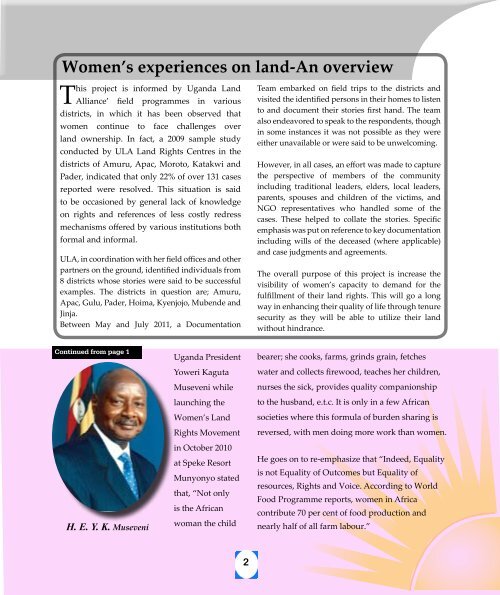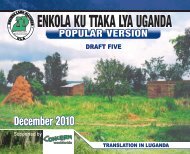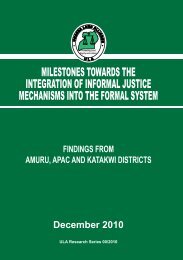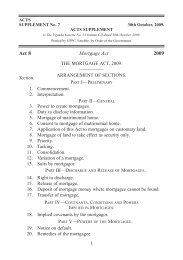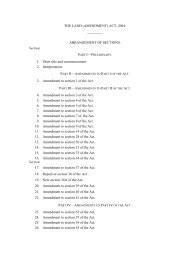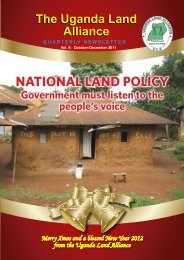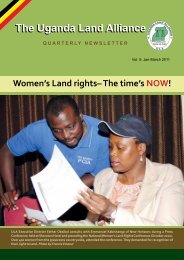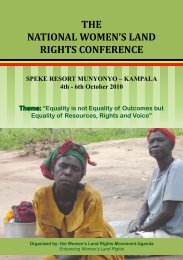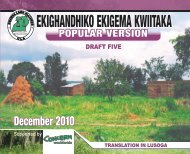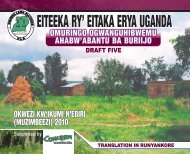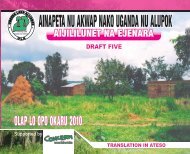A Woman & her Land - Uganda Land Alliance
A Woman & her Land - Uganda Land Alliance
A Woman & her Land - Uganda Land Alliance
- No tags were found...
Create successful ePaper yourself
Turn your PDF publications into a flip-book with our unique Google optimized e-Paper software.
Women’s experiences on land-An overviewThis project is informed by <strong>Uganda</strong> <strong>Land</strong><strong>Alliance</strong>’ field programmes in variousdistricts, in which it has been observed thatwomen continue to face challenges overland ownership. In fact, a 2009 sample studyconducted by ULA <strong>Land</strong> Rights Centres in thedistricts of Amuru, Apac, Moroto, Katakwi andPader, indicated that only 22% of over 131 casesreported were resolved. This situation is saidto be occasioned by general lack of knowledgeon rights and references of less costly redressmechanisms offered by various institutions bothformal and informal.ULA, in coordination with <strong>her</strong> field offices and ot<strong>her</strong>partners on the ground, identified individuals from8 districts whose stories were said to be successfulexamples. The districts in question are; Amuru,Apac, Gulu, Pader, Hoima, Kyenjojo, Mubende andJinja.Between May and July 2011, a DocumentationTeam embarked on field trips to the districts andvisited the identified persons in their homes to listento and document their stories first hand. The teamalso endeavored to speak to the respondents, thoughin some instances it was not possible as they wereeit<strong>her</strong> unavailable or were said to be unwelcoming.However, in all cases, an effort was made to capturethe perspective of members of the communityincluding traditional leaders, elders, local leaders,parents, spouses and children of the victims, andNGO representatives who handled some of thecases. These helped to collate the stories. Specificemphasis was put on reference to key documentationincluding wills of the deceased (w<strong>her</strong>e applicable)and case judgments and agreements.The overall purpose of this project is increase thevisibility of women’s capacity to demand for thefulfillment of their land rights. This will go a longway in enhancing their quality of life through tenuresecurity as they will be able to utilize their landwithout hindrance.Continued from page 1H. E. Y. K. Museveni<strong>Uganda</strong> PresidentYoweri KagutaMuseveni whilelaunching theWomen’s <strong>Land</strong>Rights Movementin October 2010at Speke ResortMunyonyo statedthat, “Not onlyis the Africanwoman the childbearer; she cooks, farms, grinds grain, fetcheswater and collects firewood, teaches <strong>her</strong> children,nurses the sick, provides quality companionshipto the husband, e.t.c. It is only in a few Africansocieties w<strong>her</strong>e this formula of burden sharing isreversed, with men doing more work than women.He goes on to re-emphasize that “Indeed, Equalityis not Equality of Outcomes but Equality ofresources, Rights and Voice. According to WorldFood Programme reports, women in Africacontribute 70 per cent of food production andnearly half of all farm labour.”2


